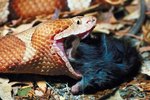Many of the more than 100 gecko species worldwide live in deserts. Of the eight species in the United States, only the desert banded gecko has its preferred habitat in its name. Carnivorous reptiles, desert geckos have very similar diets wherever they are found.
Habitat
Desert geckos are largely terrestrial, meaning they live on the ground, in the sand or on rocks, although some may climb bushes.
Nocturnal
Geckos can quickly dehydrate in the daytime sun, so they are nocturnal hunters. Their prey also tend to be nocturnal insects, although geckos will hunt out any insects available.
Cold-Blooded
Like all reptiles, desert geckos are cold-blooded and must raise their body temperatures in sand or on rocks still warm after sunset, or perhaps by basking briefly at the end of the day. As they prepare to hunt, their prey also are venturing out.
Prey in the Wild
The prey hunted by desert geckos reflects the location and size of the gecko itself. Small and large insects such as ants, beetles, termites, moths and crickets comprise a large part of the diet. Centipedes, millipedes, spiders and worms also are eaten.
Prey in Captivity
Desert geckos in captivity have a more limited diet, based on what can be provided from suppliers. Most eat crickets, mealy worms, cockroaches, silkworms and wax worms.





